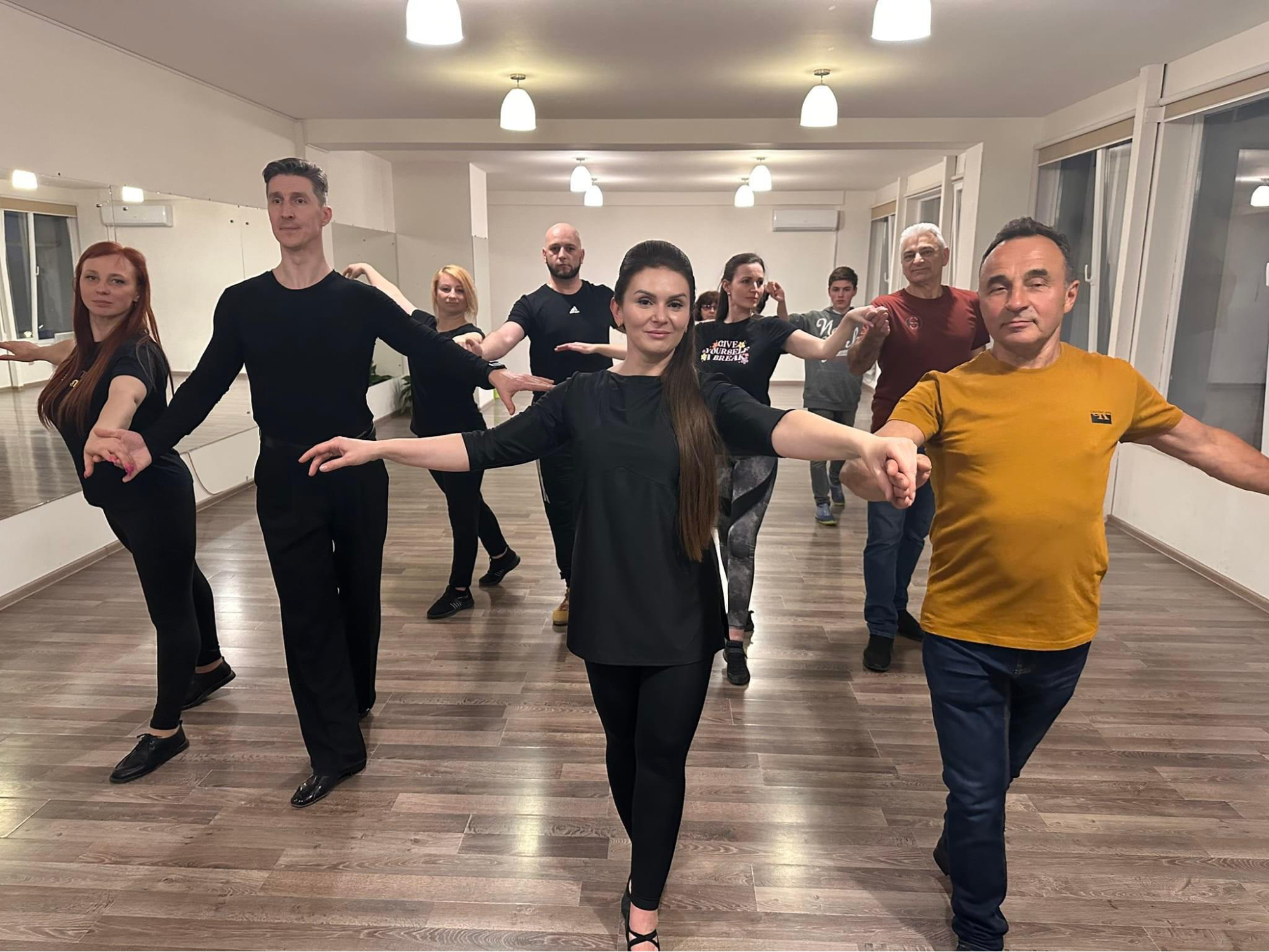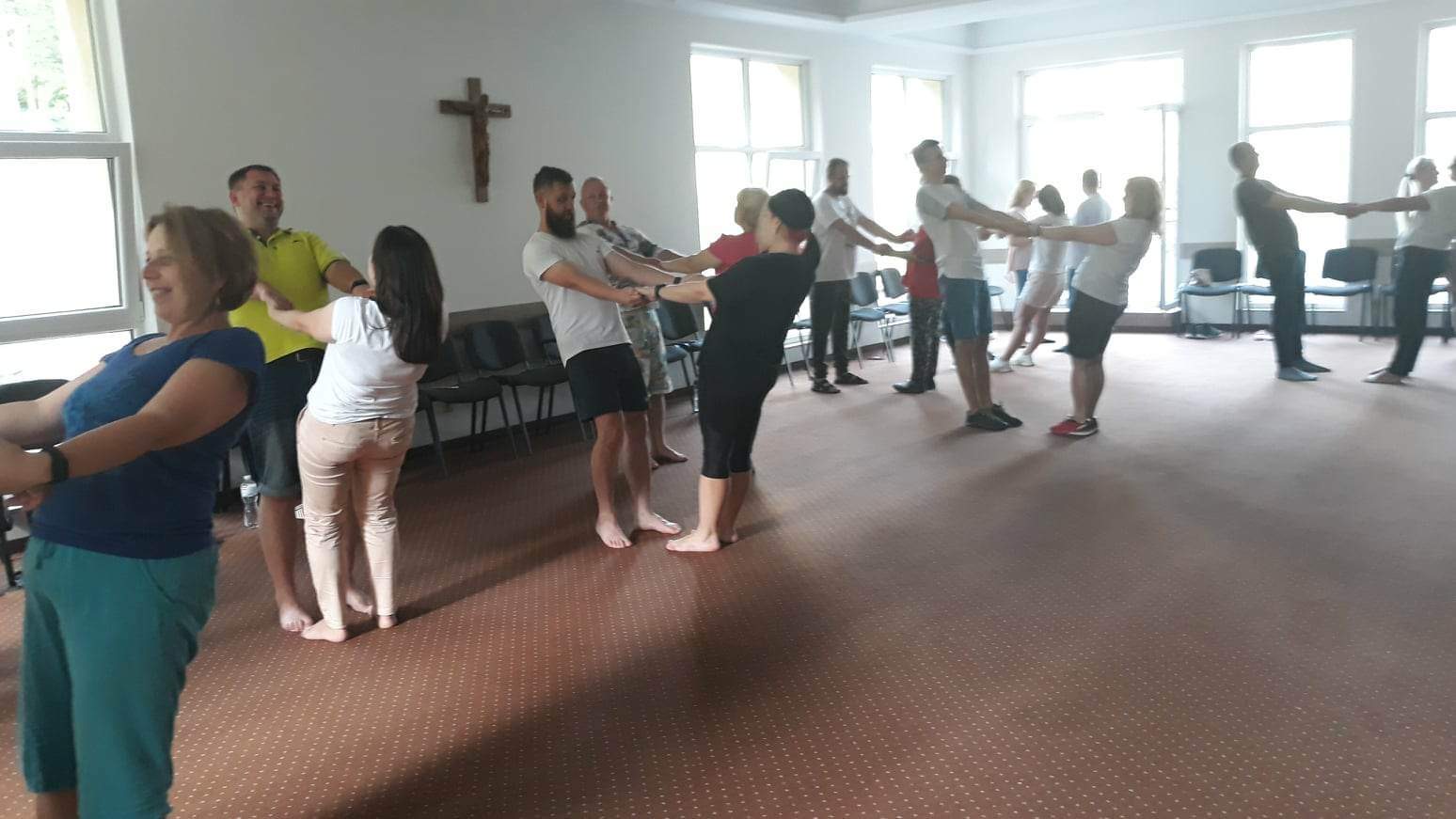
What is the problem?
Post-traumatic syndrome, flashbacks, obsessive states, and self-isolation — these are the psychological problems some veterans face after demobilization. All-round psychosocial support is also necessary for relatives of Ukrainian military personnel. Those who are waiting for defenders from the war go through the path of rehabilitation and adaptation together with the wounded and veterans.
What is the problem?
Dance rehabilitation classes for military personnel and their family members were started in Uzhhorod, the Zakarpattia region. The NGO Volunteers of Transcarpathia initiated the project. The project "Bring Me Back from the War" is social; its main goal is to help servicemembers adapt to a peaceful life through dance.
How does it work?
How dances help the return from war

Professional dancers Vitalii Erfan and Viktoriia Zaprudska conduct dance rehabilitation classes. Photo from the archive of Volunteers of Transcarpathia
As the head of Volunteers of Transcarpathia, Vlasta Reipashi said, the idea is to conduct dance rehabilitation classes. The creation of the "Bring Me Back from the War" project was inspired by an initiative with a similar name.
The "Invite me from the war" project occurred in Kyiv even before the full-scale invasion. Participants in the hostilities in the East of Ukraine and volunteers participated. Twenty couples told their stories through dance: about a mother and a son who went to defend Ukraine, lovers who got married during the war, and people who did not lose faith in life.
"The project 'Invite me from the war' had a very good response and results. However, it was a very expensive project organized by one of the Ukrainian ministries. Here, we do everything for free — to return the boys from the war and adapt them to society, physically and psychologically," says Reipashi.
She adds that the emotional state of Ukrainians is now very vulnerable, while society is not yet ready to turn to psychologists or psychotherapists en masse. That is why the organization decided to support the military and their family members with the help of dance.
Professional dancers Vitalii Erfan and Viktoriia Zaprudska conduct dance rehabilitation classes. Reipashi said they approached this as responsibly as possible, including developing a special approach to the Ukrainian military, whose health was severely affected.
"Why do we volunteer with dances? It's simple — we know how to do it, why, and what it can give. For us, dancing is a form of art, but it is also a sport, physical exercise, and moral relief," says Vitalii Erfan.

On Defender's Day, the organizers of the "Bring Me Back from the War" initiative plan to hold a ball at which project participants will perform. Photo from the archive of Volunteers of Transcarpathia
Classes for veterans and military family members have been held since March 2024. They started with a slow English waltz. Later, they plan to teach sports and Latin American dances. Veterans can come to the project with their partners. Those who do not have a partner but want to learn to dance will be helped by volunteer dancers who dance in sports groups.
Today, approximately 16 people are participating in the project. These are defenders, fighters who have returned from captivity, veterans with injuries, family members of defenders, and volunteers.

Artur Svishcho learns to dance the waltz. Photo from the archive of Volunteers of Transcarpathia
Among the participants are Serhii Dudchenko (call sign "Sultan") and Artur Svishcho. Dudchenko was a Maidan participant who was included in the book "Heroes of Modernity." He currently has a disability. Svishcho is a soldier who served in the 101st Brigade and was considered dead but was actually in captivity, where he survived torture.
"They come to dances with pleasure. In the beginning, they were shy and did not want to go. I almost forcibly brought them," says Reipashi. Some women from the families of the missing soldiers also attend classes. They say that dancing and music positively affect and relieve the nervous system. Dance movements soothe and distract from complex thoughts.
Does it really work?
What the psychologist says

Halyna Kapshii, a psychologist in the method of dance and movement therapy.
This is an important activity when dealing with anxiety, depression, sleep disorders, etc. It also expands one's movement profile (our usual set of movements, — ed.), creativity, aesthetic component, communication, and social interaction. All this can be an important component of rehabilitation.
However, the dance therapist notes that the dance lessons conducted by the choreographer can only be termed therapy. They have a purely general effect on the human condition. Kapshii recommends dancing or sports to military personnel and their relatives. However, she emphasizes that if we talk about depression or PTSD, the main method of treatment should be psychotherapy and/or medication.
Dance lessons have a general therapeutic effect. For example, a conversation in the kitchen with a friend can also have a therapeutic effect, improving our condition— because we complain, speak out, receive support, and look at something differently. But this is not therapy. In therapy, a psychotherapist with the necessary education and qualifications works specifically with the client's problem using special psychotherapeutic methods.
Dance therapy as a method of treatment

Halyna Kapshii conducts a dance therapy session. Photo from the archive of Halyna Kapshii
Dance therapy, as a method of psychotherapy, originated in the US in the middle of the last century. In particular, after the Korean War, a decision was made to involve art people (artists, choreographers, singers) in the rehabilitation of military veterans who returned from the war zone. The period after the 1950s was marked by many studies of this phenomenon and the rapid development of various therapeutic techniques related to art.
Dance therapy is a scientifically accredited method of psychotherapy that studies dance, its properties, and its impact on a person. It is included in the list of psychotherapy methods with proven effectiveness in Ukraine, approved by the Ministry of Health of Ukraine.
How does dance therapy work?
The main means of influence in this method is a free, spontaneous dance that occurs in the "here and now" moment, that is, improvisation. It is a dance without rules, predetermined movements, or fixed figures. It is about how a person feels at this moment and how they experience the world around them.
"It is important to allow yourself to move as you want in the moment. Our body has its own wisdom, and when we allow it to move spontaneously, it finds the necessary movements and its way to a gentle release of emotions and experiences, stress, recovery of resources, and, ultimately, self-healing," says Kapshii.
The psychologist explains that any emotional stress is retained by our body in the form of muscle tension, forming a so-called muscle-emotional clamp. Such clamps disrupt the natural grace of our movement, the free circulation of energy and metabolism in the body. And over time, they can lead to the formation of functional disorders in the body or even diseases. Perhaps you have heard such a term as "psychosomatics" — a disease of the body that has a psychological cause at its core. In the case of psychotrauma, unexpressed emotions trapped in the body can often form painful symptoms and mental states in the future.
Spontaneous movement allows you to identify areas of tension in the body, realize and express suppressed emotions, restore mental harmony, fluidity, and natural grace of movement. Music in dance therapy is an important but optional component because you can dance without music to your internal rhythms or melodies.
"They say that with dance, you can tell what cannot be said with words. After all, dance is a special living language that a person possesses. Our brain actively produces images, memories, emotions, and thoughts when we move. In dance, we gently experience them and express them through body movements," the expert continues. "We also have the opportunity to realize, reevaluate, and accept important things that created unrest and internal conflict within us. Sometimes dance therapy is also called meditation in motion."
Dance therapy has its own theoretical foundation — the Laban or movement analysis system. Observing exactly what movements and positions ("forms") of the body a person takes in a spontaneous dance, the dance therapist draws conclusions about the person's psychological state and accordingly builds a therapeutic process, offering certain tasks or exercises to change and improve the psychological state of a person.
Dance therapy can also use elements of different types of dance, even teaching certain movements. But dance therapy is not a dance class where we learn movements and their combinations — it is primarily an opportunity to feel, find, and live your own inner dance, the dance of your soul, the dance of your individuality and uniqueness. "Believe me, no one knows it and will dance it except you," says Kapshii.
How dance therapy affects people

Dance therapy helps restore a sense of support and trust. Photo from the archive of Halyna Kapshii
Prolonged stress rapidly exhausts the body and psyche. Dance therapy is beneficial in this case. After all, it helps relieve tension accumulated in the body and psyche for a long time, restore a sense of balance, and fill the body with resources.
In the classes, special emphasis is placed on restoring a sense of support and trust, reducing anxiety, and returning a person's sense of control and ability to influence the situation to the extent possible.
"Since with the beginning of a full-scale invasion, we all seem to have been knocked out from under our feet, to the actual dance practices, I add breathing exercises, 'grounding' techniques that contribute to calming and improving the emotional state, conscious release of tension, work with emotions," says Kapshii.
The effect of such classes can be compared to what people get during sessions with a psychotherapist because dance therapy is a type of psychotherapy. Only the treatment does not occur in the process of talking or sitting on a chair in the specialist's office, but in a space where you can move freely and involve the body in working with mental states and emotions.
Even more useful solutions!

You can dance while sitting, lying down, and even without moving. Photo from the archive of Halyna Kapshii
Dancing can have a therapeutic effect at home as well. For this, it is enough to turn on your favorite music and just start dancing.
"Dance the way you like and feel at the moment; don't control your movements in the mirror. You can dance sitting, lying down, and even do it without moving. Dance like nobody's watching you. It would be great if you could organize joint dances with the children. This will help to release tension and distract yourself," the psychologist advises.
It can be done by absolutely everyone, regardless of age, gender, or health status. Dance therapy works equally well with children, adults, older people, women and men, and people who have limited mobility or even mental disabilities.






